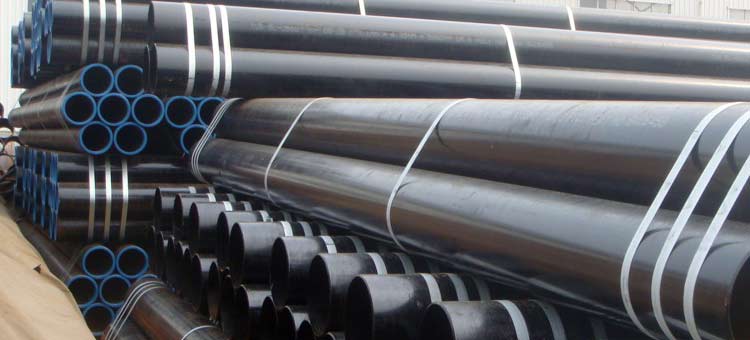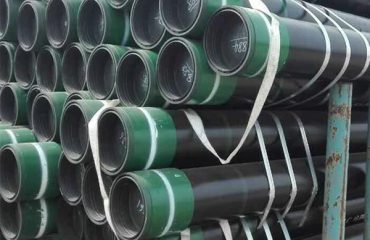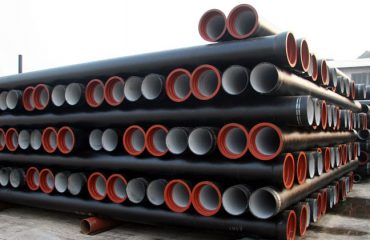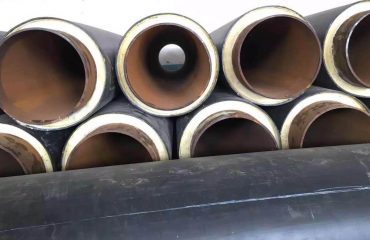
ASTM A672 Elektrofusionsgeschweißt (EFW) Stahl-Rohr
Einführung
ASTM A672 ist eine Spezifikation, die das Elektroschmelzschweißen abdeckt (EFW) Stahlrohre, die für den Hochdruckbetrieb bei gemäßigten Temperaturen ausgelegt sind. Diese Rohre werden häufig in Branchen wie der Energieerzeugung eingesetzt, Petrochemie, Öl und Gas, und Wasserübertragung. Die Spezifikation gibt Richtlinien für die Herstellung vor, testen, und Inspektion von Stahlrohren, um sicherzustellen, dass sie die erforderlichen mechanischen Eigenschaften und Leistungsanforderungen für Hochdruckanwendungen erfüllen.
Beim EFW-Verfahren handelt es sich um ein Schweißverfahren, bei dem die Stahlplatten mithilfe eines Lichtbogens miteinander verschmolzen werden, eine Längsnaht bilden. Dieses Verfahren ist hocheffizient und erzeugt Rohre mit ausgezeichneter struktureller Integrität und mechanischer Festigkeit. ASTM A672-Rohre sind in verschiedenen Qualitäten erhältlich, je nach verwendeter Stahlsorte und den erforderlichen mechanischen Eigenschaften.
In diesem Artikel wird der Herstellungsprozess untersucht, mechanische Eigenschaften, und Anwendungen von ASTM A672 EFW-Stahlrohren, sowie die Prüfmethoden, mit denen dies sichergestellt wird Qualität und Leistung.
Inhaltsverzeichnis
- Was ist ein ASTM A672 EFW-Stahlrohr??
- Herstellungsprozess von ASTM A672 EFW-Stahlrohren
- elektrisches Schmelzschweißen (EFW) Prozess
- Wärmebehandlung
- Qualitäten und Klassen von ASTM A672-Stahlrohren
- Mechanische Eigenschaften von ASTM A672 EFW-Stahlrohren
- Prüf- und Inspektionsanforderungen
- zerstörungsfreie Prüfung (NDT)
- Hydrostatische Prüfung
- Anwendungen von ASTM A672 EFW-Stahlrohren
- Häufig gestellte Fragen (FAQ)
- Fazit
Was ist ein ASTM A672 EFW-Stahlrohr?? {#Was ist ASTM-A672-EFW-Stahlrohr?}
ASTM A672 ist eine Standardspezifikation für Elektroschmelzschweißen (EFW) Stahlrohre, die für den Hochdruckbetrieb bei gemäßigten Temperaturen ausgelegt sind. Diese Rohre werden aus Druckbehältern hergestellt Qualität Stahlplatten, die mit einem Lichtbogen schmelzgeschweißt werden. Die Spezifikation gilt für Rohre mit Längsnaht und ist für den Einsatz in Anwendungen vorgesehen, bei denen hohe Festigkeit und Haltbarkeit erforderlich sind.
Hauptmerkmale von ASTM A672 EFW-Stahlrohren:
-
Elektroschmelzgeschweißt (EFW): Die Rohre werden im EFW-Verfahren hergestellt, Dabei werden die Stahlplatten mithilfe eines Lichtbogens miteinander verschmolzen. Durch dieses Verfahren entsteht eine starke Längsschweißnaht, die hohen Drücken standhält.
-
Druckbehälter Qualität Stehlen: Die bei der Herstellung von ASTM A672-Rohren verwendeten Stahlplatten sind von Druckbehälterqualität, Das heißt, sie sind so konzipiert, dass sie hohen Innendrücken ohne Ausfall standhalten.
-
Hochdruckservice: ASTM A672-Rohre sind für Hochdruckanwendungen geeignet, wie z.B. Heizkessel, Wärmetauscher, und Pipelines in der Öl- und Gasindustrie.
-
Anwendungen bei moderaten Temperaturen: Die Spezifikation umfasst Rohre, die für den Einsatz bei gemäßigten Temperaturen ausgelegt sind, typischerweise bis zu 400°C (752° F).
-
Verschiedene Qualitäten: ASTM A672-Rohre sind je nach verwendeter Stahlsorte und den erforderlichen mechanischen Eigenschaften in verschiedenen Qualitäten erhältlich. Die Qualitäten werden durch die chemische Zusammensetzung und die Wärmebehandlung des Stahls bestimmt.
Herstellungsprozess von ASTM A672 EFW-Stahlrohren {#Herstellungsprozess von ASTM-A672-EFW-Stahlrohren}
Die Herstellung von ASTM A672 EFW-Stahlrohren umfasst mehrere Schritte, einschließlich der Auswahl von Stahlplatten in Druckbehälterqualität, das elektrische Schmelzschweißen (EFW) Prozess, und Wärmebehandlung, um die gewünschten mechanischen Eigenschaften zu erreichen.
elektrisches Schmelzschweißen (EFW) Prozess {#Elektro-Schmelzschweißen-EFW-Verfahren}
Beim EFW-Verfahren handelt es sich um eine Art des Lichtbogenschweißens, bei dem die Stahlplatten mithilfe eines Lichtbogens entlang einer Längsnaht miteinander verschmolzen werden. Der Prozess umfasst die folgenden Schritte:
-
Plattenvorbereitung: Die Stahlplatten werden zunächst auf die erforderlichen Abmessungen zugeschnitten und auf Oberflächenfehler oder Unvollkommenheiten untersucht.
-
Kantenvorbereitung: Die Kanten der Stahlplatten sind abgeschrägt, um eine ordnungsgemäße Verschmelzung während des Schweißvorgangs zu gewährleisten. Der Fasenwinkel wird sorgfältig kontrolliert, um eine starke Schweißnaht zu erzielen.
-
elektrisches Schmelzschweißen: Die Platten werden Kante an Kante positioniert, und ein Lichtbogen wird verwendet, um die Kanten der Platten zu schmelzen, Erstellen eines Schweißbades. Während sich der Lichtbogen entlang der Naht bewegt, die Metallschmelze erstarrt, Es entsteht eine durchgehende Schweißnaht über die gesamte Rohrlänge.
-
Schweißnahtprüfung: Die Schweißnaht wird auf Mängel wie Porosität untersucht, Risse, oder unvollständige Fusion. Zerstörungsfreie Prüfung (NDT) Methoden, wie Ultraschallprüfungen oder Röntgenprüfungen, werden häufig verwendet, um die Qualität der Schweißnaht sicherzustellen.
-
Dimensionierung und Formgebung: Nach dem Schweißen, Das Rohr wird durch eine Reihe von Rollen geführt, um den gewünschten Durchmesser und die gewünschte Rundheit zu erreichen. Das Rohr wird außerdem auf Maßhaltigkeit überprüft.
Wärmebehandlung {#Wärmebehandlung}
Nach dem EFW-Prozess, Die Rohre können einer Wärmebehandlung unterzogen werden, um ihre mechanischen Eigenschaften zu verbessern und die beim Schweißen entstehenden Eigenspannungen abzubauen. Die Art der Wärmebehandlung hängt von der Stahlsorte und den Anwendungsanforderungen ab. Zu den gängigen Wärmebehandlungsprozessen gehören::
-
Normalisieren: Das Rohr wird auf eine Temperatur oberhalb seines kritischen Punktes erhitzt und dann an der Luft abgekühlt. Durch diesen Prozess wird die Kornstruktur verfeinert und die Zähigkeit des Stahls verbessert.
-
Abschrecken und Anlassen: Das Rohr wird auf eine hohe Temperatur erhitzt und dann schnell abgekühlt (abgeschreckt) in Wasser oder Öl. Anschließend wird es wieder auf eine niedrigere Temperatur erhitzt (temperiert) um seine Duktilität und Zähigkeit zu verbessern.
-
Stressabbauend: Das Rohr wird auf eine moderate Temperatur erhitzt und dann langsam abgekühlt, um Eigenspannungen abzubauen, ohne die mechanischen Eigenschaften wesentlich zu verändern.
Qualitäten und Klassen von ASTM A672-Stahlrohren {#Qualitäten und Klassen von ASTM-A672-Stahlrohren}
ASTM A672-Stahlrohre sind in verschiedenen Qualitäten und Klassen erhältlich, je nach verwendeter Stahlsorte und den erforderlichen mechanischen Eigenschaften. Die Qualitäten werden durch die chemische Zusammensetzung des Stahls bestimmt, während die Klassen auf den Wärmebehandlungs- und Prüfanforderungen basieren.
Gemeinsame Noten:
-
Klasse B60: Diese Sorte wird aus Kohlenstoffstahl mit einer Mindestzugfestigkeit von hergestellt 415 MPA (60,000 PSI). Es wird üblicherweise für Anwendungen mit mäßigem Druck verwendet.
-
Klasse C65: Diese Sorte wird aus Kohlenstoff-Mangan-Stahl mit einer Mindestzugfestigkeit von hergestellt 450 MPA (65,000 PSI). Es ist für Anwendungen mit höherem Druck geeignet.
-
Klasse C70: Diese Sorte wird aus Kohlenstoff-Mangan-Stahl mit einer Mindestzugfestigkeit von hergestellt 485 MPA (70,000 PSI). Es wird in Hochdruckanwendungen eingesetzt, bei denen Festigkeit und Haltbarkeit von entscheidender Bedeutung sind.
Klassen:
- Klasse 10: Rohre dieser Klasse werden im geschweißten Zustand ohne Wärmebehandlung geliefert.
- Klasse 12: Rohre dieser Klasse werden nach dem Schweißen wärmebehandelt, um ihre mechanischen Eigenschaften zu verbessern und Eigenspannungen abzubauen.
- Klasse 22: Rohre dieser Klasse werden vergütet, um eine höhere Festigkeit und Zähigkeit zu erreichen.
Materialspezifikation {#Materialspezifikation}
ASTM A672 Rohre werden daraus hergestellt Hochwertige Stahlplatten für Druckbehälter die mit dem geschweißt werden elektrisches Schmelzschweißen (EFW) Prozess. Die Spezifikation umfasst Rohre in verschiedenen Ausführungen Klasse und Klassen, die durch die bestimmt werden Chemische Zusammensetzung des Stahls und der Wärmebehandlung nach dem Schweißen aufgetragen.
Hauptmerkmale von ASTM A672 EFW-Stahlrohren:
- Elektroschmelzgeschweißt (EFW): Rohre werden mit einem geschweißt elektrischer Lichtbogen zum Verschmelzen von Stahlplatten, Erstellen eines Längsnaht.
- Druckbehälter aus Qualitätsstahl: Die verwendeten Stahlplatten sind aus Druckbehälterqualität, Stellen Sie sicher, dass die Rohre standhalten hohe Innendrücke.
- Hochdruckservice: ASTM A672-Rohre sind für ausgelegt Hochdruckanwendungen bei gemäßigte Temperaturen.
- Noten und Klassen: Die Spezifikation sieht mehrere vor Klasse und Klassen basierend auf der Chemische Zusammensetzung und Wärmebehandlung des Stahls.
Tabelle der chemischen Zusammensetzung {#Tabelle der chemischen Zusammensetzung}
Die chemische Zusammensetzung von ASTM A672-Stahlrohren variiert je nach Klasse des verwendeten Stahls. In der folgenden Tabelle ist die typische chemische Zusammensetzung für gängige Qualitäten aufgeführt, die in ASTM A672-Rohren verwendet werden.
| ELEMENT | Klasse B60 (%) | Klasse C65 (%) | Klasse C70 (%) |
|---|---|---|---|
| KOHLENSTOFF (C) | 0.26 max | 0.24 max | 0.23 max |
| Mangan (MN) | 0.98 max | 1.20 max | 1.35 max |
| Phosphor (P) | 0.035 max | 0.035 max | 0.035 max |
| Schwefel (S) | 0.035 max | 0.035 max | 0.035 max |
| Silizium (Si) | 0.13-0.45 | 0.13-0.45 | 0.13-0.45 |
| Chrom (Cr) | 0.30 max | 0.30 max | 0.30 max |
| Nickel (Ni) | 0.30 max | 0.30 max | 0.30 max |
| Molybdän (Mo) | 0.12 max | 0.12 max | 0.12 max |
| Kupfer (Cu) | 0.40 max | 0.40 max | 0.40 max |
| Vanadium (V) | 0.08 max | 0.08 max | 0.08 max |
Anmerkungen:
- Kohlenstoffgehalt ist ein Schlüsselfaktor bei der Bestimmung Stärke und Härte des Stahls. Ein geringerer Kohlenstoffgehalt verbessert sich Schweißbarkeit und Duktilität.
- Mangan verbessert die Zugfestigkeit und Härtbarkeit des Stahls.
- Phosphor und Schwefel werden auf niedrigem Niveau gehalten, um dies zu verhindern Sprödigkeit und Zähigkeit verbessern.
- Silizium fungiert als Desoxidationsmittel während des Stahlherstellungsprozesses und verbessert sich Stärke.
Tabelle der mechanischen Eigenschaften {#Tabelle der mechanischen Eigenschaften}
Die mechanischen Eigenschaften von ASTM A672-Stahlrohren werden durch bestimmt Klasse und Klasse des Rohres, sowie die Wärmebehandlung nach dem Schweißen aufgetragen. Die folgende Tabelle enthält die typischen mechanischen Eigenschaften für gängige ASTM A672-Rohrqualitäten.
| Eigentum | Klasse B60 | Klasse C65 | Klasse C70 |
|---|---|---|---|
| Zugfestigkeit (MPA) | 415 min (60,000 PSI) | 450 min (65,000 PSI) | 485 min (70,000 PSI) |
| Streckgrenze (MPA) | 240 min (35,000 PSI) | 275 min (40,000 PSI) | 275 min (40,000 PSI) |
| DEHNUNG (%) | 22 min | 22 min | 22 min |
| Schlagzähigkeit (j) | Variiert je nach Klasse | Variiert je nach Klasse | Variiert je nach Klasse |
Anmerkungen:
- Zugfestigkeit ist die maximale Belastung, der das Material standhalten kann, bevor es bricht.
- Streckgrenze ist die Spannung, bei der sich das Material plastisch zu verformen beginnt.
- DEHNUNG ist ein Maß für die Duktilität des Materials, Gibt an, wie weit es sich dehnen kann, bevor es bricht.
- Schlagzähigkeit wird typischerweise mit gemessen Charpy V-Notch-Tests, insbesondere für Anwendungen in Umgebungen mit niedrigen Temperaturen.
Prüf- und Inspektionsanforderungen {#Prüf- und Inspektionsanforderungen}
Um die Qualität und Leistung von ASTM A672 EFW-Stahlrohren sicherzustellen, Während des Herstellungsprozesses kommen verschiedene Prüf- und Inspektionsmethoden zum Einsatz. Diese Tests helfen dabei, etwaige Mängel oder Inkonsistenzen im Material oder in der Schweißnaht zu erkennen, die die mechanischen Eigenschaften oder die strukturelle Integrität des Rohrs beeinträchtigen könnten.
zerstörungsfreie Prüfung (NDT) {#zerstörungsfreie-prüfung-ndt}
zerstörungsfreie Prüfung (NDT) Dabei werden Verfahren eingesetzt, um die Schweißnaht und den Rohrkörper auf Fehler zu untersuchen, ohne das Material zu beschädigen. Zu den gängigen ZfP-Methoden gehören::
-
Ultraschalluntersuchung (OUT): Mithilfe von Ultraschallwellen werden innere Defekte wie Risse erkannt, Hohlräume, oder unvollständige Verschmelzung in der Schweißnaht oder im Rohrkörper.
-
Röntgenprüfung (RT): Mithilfe von Röntgen- oder Gammastrahlen wird ein Bild der Schweißnaht erstellt, So können Prüfer interne Mängel wie Porosität erkennen, Schlackeneinschlüsse, oder Risse.
-
Prüfung von Magnetpulvern (MT): Diese Methode dient zur Erkennung von Oberflächenfehlern in ferromagnetischen Materialien. An das Rohr wird ein Magnetfeld angelegt, und Eisenpartikel werden verwendet, um etwaige Risse oder Unregelmäßigkeiten auf der Oberfläche aufzudecken.
-
Farbeindringprüfung (Pt): Auf die Oberfläche des Rohres wird ein Farbstoff aufgetragen, und eventuelle Risse oder Defekte absorbieren den Farbstoff, sie unter ultraviolettem Licht sichtbar machen.
Hydrostatische Prüfung {#Hydrostatische Prüfung}
Die hydrostatische Prüfung ist eine wichtige Prüfung, mit der sichergestellt wird, dass das Rohr dem Innendruck standhält, dem es im Betrieb ausgesetzt ist. Während dieses Tests, Das Rohr ist mit Wasser gefüllt und steht unter einem Druck, der über seinem Betriebsdruck liegt. Anschließend wird das Rohr auf Undichtigkeiten oder Verformungen untersucht, die auf eine Material- oder Schweißnahtschwäche hinweisen könnten.
- Prüfungsangst: Der Prüfdruck beträgt typischerweise 1.5 mal dem Auslegungsdruck des Rohres.
- Dauer: Das Rohr wird für einen bestimmten Zeitraum auf dem Prüfdruck gehalten (normalerweise 5 An 15 Minuten) um sicherzustellen, dass der Druck störungsfrei aufrechterhalten werden kann.
Anwendungen von ASTM A672 EFW-Stahlrohren {#Anwendungen-von-astm-a672-efw-steel-pipe}
ASTM A672 EFW-Stahlrohre werden in einer Vielzahl von Branchen und Anwendungen eingesetzt, in denen Hochdruckbetrieb und strukturelle Integrität von entscheidender Bedeutung sind. Einige häufige Anwendungen umfassen:
-
Energieerzeugung: ASTM A672-Rohre werden in Kesseln verwendet, Wärmetauscher, und Dampfleitungen in Kraftwerken aufgrund ihrer Fähigkeit, hohen Drücken und moderaten Temperaturen standzuhalten.
-
petrochemische Industrie: Diese Rohre werden in Raffinerien eingesetzt, Chemieanlagen, und petrochemische Anlagen zum Transport korrosiver Flüssigkeiten und Gase unter hohem Druck.
-
Öl-und Gasindustrie: ASTM A672-Rohre werden in Öl- und Gaspipelines verwendet, Offshore-Plattformen, und Unterwasserpipelines zum Transport von Rohöl, Erdgas, und andere Kohlenwasserstoffe.
-
Wasserübertragung: Diese Rohre werden in Wasserübertragungssystemen zum Transport von Trinkwasser verwendet, Abwasser, und Brauchwasser unter hohem Druck.
-
Strukturelle Anwendungen: ASTM A672-Rohre werden in strukturellen Anwendungen wie Säulen verwendet, Balken, und Stützen in Gebäuden und Industriekonstruktionen, wo Festigkeit und Haltbarkeit erforderlich sind.
Häufig gestellte Fragen (FAQ) {#FAQ}
1. Was ist der Unterschied zwischen EFW- und ERW-Rohren??
EFW (Elektroschmelzgeschweißt) Rohre werden mithilfe eines Lichtbogens verschweißt, um die Stahlplatten miteinander zu verschmelzen, während ERW (Elektrischer Widerstand Geschweißt) Rohre werden unter Verwendung elektrischen Widerstands geschweißt, um die Kanten des Stahls zu erhitzen und sie miteinander zu verschmelzen. EFW-Rohre werden typischerweise für Hochdruckanwendungen verwendet, während ERW-Rohre für Anwendungen mit niedrigem bis mittlerem Druck verwendet werden.
2. Was sind die gängigen Qualitäten von ASTM A672-Rohren??
Zu den gängigen Sorten von ASTM A672-Rohren gehört die Sorte B60, Klasse C65, und Klasse C70, die auf der chemischen Zusammensetzung und den mechanischen Eigenschaften des Stahls basieren.
3. Was ist die maximale Betriebstemperatur für ASTM A672-Rohre??
ASTM A672-Rohre sind für den Einsatz bei gemäßigten Temperaturen ausgelegt, typischerweise bis zu 400°C (752° F), Abhängig von der Qualität und Klasse des Rohrs.
4. Wie wird die Qualität von ASTM A672-Rohren sichergestellt??
Die Qualität der ASTM A672-Rohre wird durch zerstörungsfreie Tests sichergestellt (NDT) Methoden wie Ultraschallprüfung, Röntgenprüfung, und Magnetpulverprüfung, sowie hydrostatische Tests, um die Fähigkeit des Rohrs zu überprüfen, dem Innendruck standzuhalten.
5. In welchen Branchen werden ASTM A672 EFW-Stahlrohre verwendet??
ASTM A672 EFW-Stahlrohre werden in Branchen wie der Energieerzeugung eingesetzt, Petrochemie, Öl und Gas, und Wasserübertragung aufgrund ihrer Fähigkeit, hohen Drücken und moderaten Temperaturen standzuhalten.
Fazit {#Fazit}
ASTM A672 EFW-Stahlrohre sind für den Hochdruckbetrieb bei moderaten Temperaturen ausgelegt, Damit eignen sie sich ideal für den Einsatz in Branchen wie der Energieerzeugung, Petrochemie, Öl und Gas, und Wasserübertragung. das elektrische Schmelzschweißen (EFW) Das Verfahren gewährleistet eine starke Längsnaht, die hohen Innendrücken standhält, Die Verwendung von Stahl in Druckbehälterqualität stellt sicher, dass die Rohre über die erforderlichen mechanischen Eigenschaften für anspruchsvolle Anwendungen verfügen.
Die in ASTM A672 beschriebenen Test- und Inspektionsanforderungen, einschließlich zerstörungsfreier Prüfung und hydrostatischer Prüfung, tragen dazu bei, die Qualität und Leistung der Rohre sicherzustellen, Dies macht sie zu einer zuverlässigen Wahl für Hochdruck- und Strukturanwendungen.




Sie müssen eingeloggt sein, um ein Kommentar abzugeben.